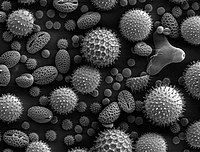
Photo from wikipedia
Abstract The grass pollen season was monitored at the Biological Station Lake Neusiedl (Burgenland, Austria) during 2017, 2018 and 2019 by means of a Hirst-type volumetric pollen and spore trap.… Click to show full abstract
Abstract The grass pollen season was monitored at the Biological Station Lake Neusiedl (Burgenland, Austria) during 2017, 2018 and 2019 by means of a Hirst-type volumetric pollen and spore trap. While the start, end, duration and peaks of the pollen seasons varied between the years, both showed a late occurrence of grass pollen in the air with more than 20 grass pollen/m3 air in September. This late flowering event is unusual for Austria and was only noticed at the pollen monitoring site in Illmitz. The site is characterised by reed vegetation surrounding the station. The reed plants were determined as Phragmites australis and phenologically monitored in September 2018. The local plants flowered during this period. Thus, the source of the significant grass pollen exposure in September could be attributed to a local phenomenon. Other places surrounded by reed grasses should be monitored to assess the consistency of the observed pattern and variation of the flowering of Phragmites. The exposure to grass pollen has to be communicated to persons affected by grass pollen allergy including the incorporation of such events into pollen forecasting routines.
Journal Title: Grana
Year Published: 2020
Link to full text (if available)
Share on Social Media: Sign Up to like & get
recommendations!